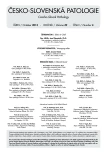Laser capture microdissection and its practical applications
Authors:
Pavla Lužná; Jiří Ehrmann Jr.
Authors‘ workplace:
Ústav histologie a embryologie, Lékařská fakulta Univerzity Palackého v Olomouci
Published in:
Čes.-slov. Patol., 49, 2013, No. 4, p. 123-125
Category:
Review articles
Overview
Laser capture microdissection is a relatively young method used both in biomedical sciences as in other studies of animal and vegetable tissues and cells. Current human medicine and its methods of investigation are based on both current established processes, and simultaneously there are new experimental approaches from molecular biology tested. In this context it is highly desirable that the studied tissue is homogenous and representative population of cells. For this purposes at the late 80’s the method of laser capture microdissection (LCM) has been developed, the first publication dealing with this method was released even in 1996. In current databases of literature we are able to find hundreds of papers focused on LCM such a method or as a part of methodic approach of experiments whose results led to the improved knowledge of genetic and proteomic nature of various diseases. This knowledge is of great promise for successful targeted therapy in the future.
Keywords:
laser capture microdissection – tissue – molecular biology applications
Sources
1. Emmert-Buck MR, Bonner RF, Smith PD, et al. Laser capture microdissection. Science 1996; 274(5289): 998-1001.
2. Webb T. Laser capture microdissection comes into mainstream use. J Natl Cancer Inst 2000; 92(21): 1710-1711.
3. Fend F, Raffeld M. Laser capture microdissection in pathology. J Clin Pathol 2000; 53(9): 666-672.
4. Ossi J, Lee A, Zhou J. Leica AS LMD – The Latest Advance in Laser Microdissection. Scientific and Technical Information 2005; CDR 8: 114–122.
5. Lužná P, Gregar J, Überall I, Radová L, Procházka V, Ehrmann J jr. Changes of microRNAs-192, 196a and 203 correlate with Barrett’s esophagus diagnosis and its progression compared to normal healthy individuals. Diagn Pathol 2011; 6:114.
6. Noutsias M, Rohde M, Block A, et al. Preamplification techniques for real-time RT-PCR analyses of endomyocardial biopsies. BMC Mol Biol 2008; 9: 3.
7. Domazet B, MacLennan GT, Lopez-Beltran A, Montironi R, Cheng L. Laser capture microdissection in the genomic and proteomic era: targeting the genetic basis of cancer. Int J Clin Exp Pathol 2008; 1(6): 475-488.
8. Xu Y, Cao LQ, Jin LY, et al. Quantitative proteomic study of human lung squamous carcinoma and normal bronchial epithelial acquired by laser capture microdissection. J Biomed Biotechnol 2012; 2012: 510418.
9. Lieberfarb ME, Lin M, Lechpammer M, et al. Genome-wide Loss of Heterozygosity Analysis from Laser Capture Microdissected Prostate Cancer Using Single Nucleotide Polymorphic Allele (SNP) Arrays and a Novel Bioinformatics Platform dChipSNP1,2. Cancer Research 2003; 63: 4781–4785.
10. Di Cristofano C, Mrad K, Zavaglia K, et al. Papillary lesions of the breast: a molecular progression? Breast Cancer Res Treat 2005; 90(1): 71-76.
11. Nelson P, Kiriakidou M, Sharma A, Maniataki E, Mourelatos Z. The microRNA world: small is mighty. Trends Biochem Sci 2003; 28(10): 534-540.
12. Griffiths-Jones S, Grocock RJ, van Dongen S, Bateman A, Enright AJ. miRBase: microRNA sequences, targets and gene nomenclature. Nucleic Acids Res 2006; 34(Database issue): D140-144.
13. Siebolts U, Varnholt H, Drebber U, et al. Tissues from routine pathology archives are suitable for microRNA analyses by quantitative PCR. J Clin Pathol 2009; 62(1): 84-88.
14. Mirnezami AH, Pickard K, Zhang L, Primrose JN, Packham G. MicroRNAs: key players in carcinogenesis and novel therapeutic targets. Eur J Surg Oncol 2009; 35(4): 339-347.
15. Turashvili G, Bouchal J, Baumforth K, et al. Novel markers for differentiation of lobular and ductal invasive breast carcinomas by laser microdissection and microarray analysis. BMC Cancer 2007; 7: 55.
16. Nonn L, Vaishnav A, Gallagher L, Gann PH. mRNA and micro-RNA expression analysis in laser-capture microdissected prostate biopsies: valuable tool for risk assessment and prevention trials. Exp Mol Pathol 2010, 88(1): 45-51.
17. Sluka P, O’Donnell L, McLachlan RI, Stanton PG. Application of laser-capture microdissection to analysis of gene expression in the testis. Prog Histochem Cytochem 2008; 42(4): 173-201.
18. Zhu G, Reynolds L, Crnogorac-Jurcevic T et al. Combination of microdissection and microarray analysis to identify gene expression changes between differentially located tumour cells in breast cancer. Oncogene 2003; 22(24): 3742-3748.
19. Noppert SJ, Eder S, Rudnicki M. Laser-capture microdissection of renal tubule cells and linear amplification of RNA for microarray profiling and real-time PCR. Methods Mol Biol 2011; 755: 257-266.
Labels
Anatomical pathology Forensic medical examiner ToxicologyArticle was published in
Czecho-Slovak Pathology

2013 Issue 4
Most read in this issue
- How to improve the histopathological diagnosis of hepatocellular benign affections (adenoma versus focal nodular hyperplasia) in daily practice?
- Immunophenotypization by means of flow cytometry in pathology
- Minimal residual disease – detection possibilities in haematological and non-haematological malignancies
- Fluorescence in situ hybridization on histologic sections
